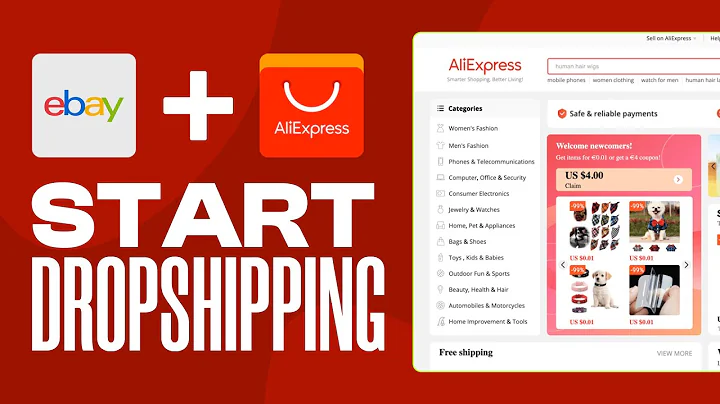The Beginner's Guide to Dropshipping: Pros, Cons, and How to Succeed
Table of Contents:
- Introduction to dropshipping
- What is Dropshipping?
- Pros of Dropshipping
3.1 Simple Business Model
3.2 Low Risk
3.3 Low Barrier of Entry
- Cons of Dropshipping
4.1 Less Control
4.2 Shipping Times
4.3 Competitiveness
4.4 Reliance on Suppliers
- Finding Suppliers
5.1 Alibaba and Aliexpress
5.2 Etsy, eBay, and Local Options
- Finding a Niche
- Branding and Packaging
- Becoming Proactive in Dropshipping
- The Importance of Patience
- Conclusion
Introduction to Dropshipping
Dropshipping has become a popular term in the e-commerce industry. Many aspiring entrepreneurs are intrigued by the idea of starting their own business with minimal investment and resources. In this beginner's guide, we will delve into the concept of dropshipping, its benefits and drawbacks, and provide valuable insights on how to start a successful dropshipping business.
What is Dropshipping?
At its core, dropshipping is an e-commerce business model that allows entrepreneurs to sell products without holding any inventory. In a traditional retail business, the seller would purchase products in bulk, store them in a warehouse, handle packaging and shipping, and manage inventory. However, in dropshipping, the seller acts as a middleman between the supplier and the customer. When a customer places an order, the seller transfers the details to the supplier, who then ships the product directly to the customer. This eliminates the need for inventory management, warehousing, and shipping logistics.
Pros of Dropshipping
3.1 Simple Business Model
One of the primary advantages of dropshipping is its simplicity. Unlike traditional business models, dropshipping is easy to understand and implement. You don't need a high level of education or extensive business experience to get started. This makes it an attractive option for beginners who are new to entrepreneurship.
3.2 Low Risk
In dropshipping, you don't need to purchase products upfront, which significantly reduces the risk involved. If a product doesn't sell well, you don't incur any losses. The absence of inventory holding also eliminates the risk of unsold stock, which can tie up capital in traditional retail businesses.
3.3 Low Barrier of Entry
Another appealing aspect of dropshipping is its low barrier of entry. Unlike traditional retail businesses that require substantial investments in inventory and infrastructure, dropshipping can be started with minimal capital. The main expenses are associated with setting up a website and marketing the products.
Cons of Dropshipping
4.1 Less Control
One of the disadvantages of dropshipping is the reduced control that sellers have over the product and its delivery. Since you rely on suppliers to handle the inventory and shipping, you may face challenges in managing customer satisfaction, especially if the suppliers' performance is subpar.
4.2 Shipping Times
Dropshipping can be challenging when it comes to shipping times. If your suppliers are located far away from your target market, it may result in long shipping times. Delayed deliveries can impact customer satisfaction and potentially affect your business's reputation.
4.3 Competitiveness
With its low risk and low barrier of entry, dropshipping has become a highly competitive market. Many entrepreneurs are attracted to its simplicity, leading to a saturation of products and sellers. This intense competition can make it difficult to stand out and generate substantial profits.
4.4 Reliance on Suppliers
In a dropshipping business, your success is heavily reliant on your suppliers. If the suppliers decide to increase their prices or face any operational issues, it can directly impact your business. Being dependent on suppliers for stock availability and quality requires careful supplier selection and maintaining good relationships.
Finding Suppliers
5.1 Alibaba and Aliexpress
When it comes to finding suppliers, Alibaba is a popular platform for bulk orders. It connects businesses with manufacturers and wholesalers around the world. On the other hand, for smaller orders and testing the waters, Aliexpress is a preferred option. It provides access to a vast range of products and suppliers that cater to dropshipping ventures.
5.2 Etsy, eBay, and Local Options
In addition to Alibaba and Aliexpress, there are alternative options for finding suppliers. Platforms like Etsy and eBay offer unique and handmade products that can be resold through dropshipping. Additionally, exploring local options such as sourcing products from local artisans or manufacturers can provide a personalized touch to your business.
Finding a Niche
To succeed in dropshipping, it is essential to find a profitable niche. A niche refers to a specific segment or category of products that have high demand but limited competition. It is crucial to conduct thorough market research to identify niche products that haven't been saturated by other drop shippers. Avoid choosing generic products that are already being sold by numerous sellers, as it can result in fierce competition and low profit margins.
Branding and Packaging
Differentiating your dropshipping business from the competition can be achieved through branding and packaging. Some suppliers offer the option to personalize packaging labels, allowing you to create a unique brand identity. Putting effort into creating appealing product photos can also enhance customer conversion rates. By personalizing packaging and emphasizing your brand, you can create a memorable customer experience and increase brand recognition.
Becoming Proactive in Dropshipping
To thrive in the dropshipping industry, it is crucial to adopt a proactive approach. This involves diversifying your product range and constantly testing different products in the market. Observing market trends and analyzing the demand during specific periods, such as festive events or seasonal fluctuations, can help identify high-selling products. Being adaptable and open to change is vital, as the dropshipping market is dynamic, and what succeeds today may not perform well in the future.
The Importance of Patience
While dropshipping may seem like a quick way to generate profits, it is essential to remain patient and realistic. Building a successful dropshipping business takes time, experimentation, and persistence. Failure is part of the learning process, and it is crucial to learn from both your own experiences and the strategies employed by successful dropshippers. By staying committed and continually learning, you can increase your chances of long-term success in the dropshipping industry.
Conclusion
Starting a dropshipping business can be an exciting and rewarding venture for aspiring entrepreneurs. By selecting a profitable niche, securing reliable suppliers, and implementing effective marketing strategies, you can create a successful online store with minimal upfront investment. While dropshipping offers numerous advantages, it is important to be aware of the drawbacks and challenges associated with this business model. By staying proactive, patient, and dedicated, you can navigate the competitive landscape and build a profitable dropshipping business.



















